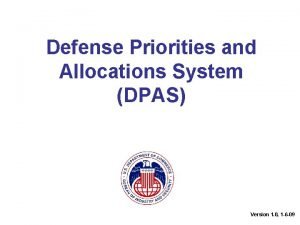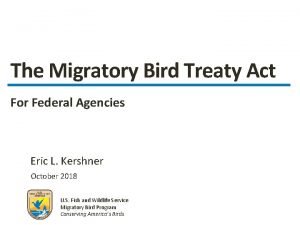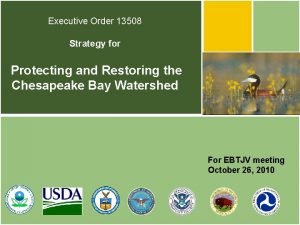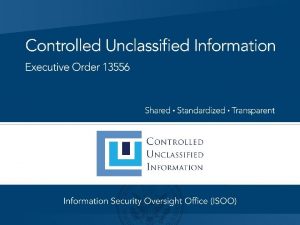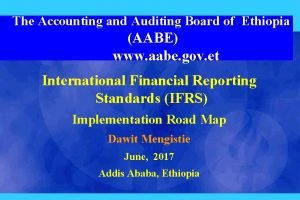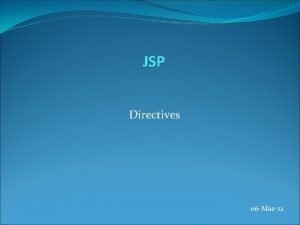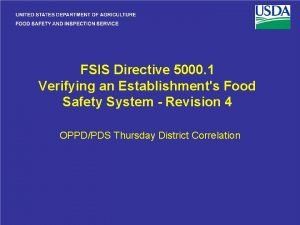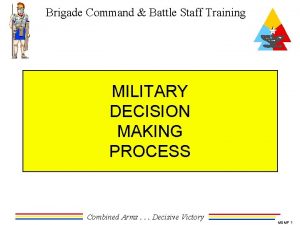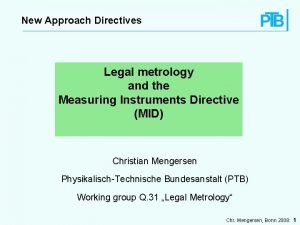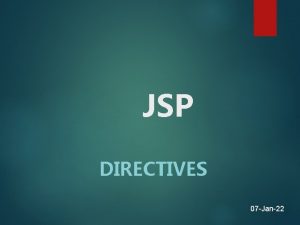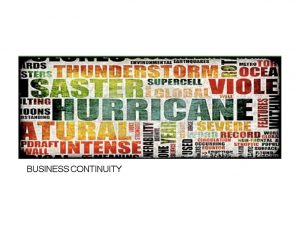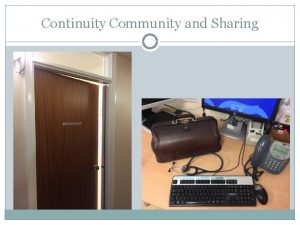Executive Order 12656 Presidential Decision Directives and Continuity












































- Slides: 44

Executive Order 12656, Presidential Decision Directives and Continuity of Operations Planning GSA EMERGENCY MANAGEMENT OFFICE

Purpose To provide an overview of Presidential Decision Directives and related Continuity of Operations (COOP) roles and responsibilities: · · · Historical Background PDD Overview and Requirements FEMA’s role as Executive Agent COOP requirements D/A COOP Guidance GSA’s Responsibilities GSA EMERGENCY MANAGEMENT OFFICE

Definition COOP: Effort within individual departments and agencies to assure continuance of their minimum essential functions across a wide range of potential emergencies. (EO 12656, Federal Response Plan, Counterterrorism, Critical Infrastructure Protection) GSA EMERGENCY MANAGEMENT OFFICE

Historical Background In the beginning……. . The White House created Executive Order 12656 GSA EMERGENCY MANAGEMENT OFFICE

Historical Background E. O. 12656 assign national security emergency preparedness responsibilities to Federal departments and agencies. The Order did not provide for: • • Minimal Federal level guidance No single POC as oversight No dedicated COOP planning Individual D/A efforts varied GSA EMERGENCY MANAGEMENT OFFICE

Historical Background The Changing Threat OLD • • Single (Soviet) Survival at Stake Known Deterrable Strategic Use of Nukes Overt Europe-Centered High Risk of Escalation NEW • • Diverse American Interest at Stake Unknown Non-Deterrable Terrorist Use of WMDs Covert Regional, Ill-Defined Little Risk of Escalation GSA EMERGENCY MANAGEMENT OFFICE

Threats change GSA EMERGENCY MANAGEMENT OFFICE

Feb 26, 1993

Apr 19, 1995

GSA EMERGENCY MANAGEMENT OFFICE

Historical Background After the Oklahoma City bombing, a renewed emphasis in COOP Activities • New threat paradigm: WMD and asymmetric threats • PDD 39 Counter-terrorism, 6/95 • PDD 62 Terrorism, 5/98 • PDD 63 Critical Infrastructure Protection, 5/98 • PDD 67 Continuity of Operations, 10/98 GSA EMERGENCY MANAGEMENT OFFICE

PDD 63 Overview Presidential Decision Directive 63 On May 22, 1998, the President ordered the strengthening of the nation's defenses against emerging unconventional threats to the United States to include those involving terrorist acts, weapons of mass destruction, assaults on our critical infrastructures, and cyber-based attacks. GSA EMERGENCY MANAGEMENT OFFICE

PDD 63 Overview Presidential Decision Directive 63 The Critical Infrastructure Protection Directive (PDD-63) calls for a national-level effort to assure the security of the increasingly vulnerable and interconnected infrastructures of the United States. GSA EMERGENCY MANAGEMENT OFFICE

PDD 63 Overview Presidential Decision Directive 63 A major component of this directive involves the development and implementation of a plan by each department and agency of the Federal Government to protect its own critical infrastructure, to include, but not limited, to its cyber-based systems. GSA EMERGENCY MANAGEMENT OFFICE

PDD 63 Overview Presidential Decision Directive 63 Major Elements of the critical infrastructure encompasses the following essential asset categories: n n n Telecommunications and telephony Information technology Physical infrastructure GSA EMERGENCY MANAGEMENT OFFICE

Introduction of PDD 67 In October of 1998, PDD 67 was introduced. PDD 67 became the foundation for other terrorist-related PDD’s and FPC’s. The triad of interrelated policies and programs (62, 63 & 67) enhance the credibility of our overall national security posture. GSA EMERGENCY MANAGEMENT OFFICE

Impact of PDD 67 As organizations began developing their COOP plan, it was realized that coordinating the different teams that had been formed (related to each PDD) was essential. Many agencies have defined a unified team that has responsibility for coordinating the different PDD elements into a single agency COOP. GSA EMERGENCY MANAGEMENT OFFICE

PDD 67 Overview Presidential Decision Directive 67 • • Recognizes emerging threats Stresses continuation of Federal government essential operations in an all-hazards environment GSA was assigned responsibilities Designates FEMA as Executive Agent for COOP GSA EMERGENCY MANAGEMENT OFFICE

PDD 67 Requirements PDD-67 COOP Requirements • Viable D/A COOP capability by October 21, 1999 - All hazards approach - Alternate facilities - Operate within 12 hrs of activation - Sustain for up to 30 days GSA EMERGENCY MANAGEMENT OFFICE

COOP Leadership PDD 67 provided GSA with several COOP related opportunities: n n n Conduct training and insure compliance with all FPC, PDD and EO requirements Work with FEMA to develop and distribute Federal Preparedness Circulars Support program for identifying and maintaining a list of alternate facilities to support COOP. GSA EMERGENCY MANAGEMENT OFFICE

GSA’s role GSA’s Roles and Responsibilities • Coordinate with FEMA to develop and conduct a plan to issue periodic guidance to the federal family in the form of a Federal Preparedness Circular; • Conduct training for department and agencies, to ensure that they comply with the requirements and objectives of the COOP directives; GSA EMERGENCY MANAGEMENT OFFICE

GSA’s role GSA’s Roles and Responsibilities • Develop and implement a plan that will ensure all departments and agencies identify required alternate facilities to support the COOP requirements; • In coordination with DOD develop a plan and mechanism for collecting, maintaining, and distributing a database of Continuity of Operations (COOP). GSA EMERGENCY MANAGEMENT OFFICE

GSA’s role GSA’s Roles and Responsibilities • Ensure that a national inventory of alternate facilities is maintained, updated, and resolve conflicts; approve standards and procedures for site searches and selection, and archiving information as assisted by DOD. GSA EMERGENCY MANAGEMENT OFFICE

GSA’s training role In June 1999, GSA launched an internal COOP training program. This program is currently available to all departments and agencies. Over 500 individuals representing 40 agencies and departments have participated in the course. Classes are scheduled through June, 2001. Agencies can request “special” classes. GSA EMERGENCY MANAGEMENT OFFICE

GSA’s training role GSA, in conjunction with its Test, Training and Exercise (TT&E) responsibility, has also initiated an Exercise Design Course. This course is designed to enable departments and agencies to develop effective methods of validating procedures and processes identified in their COOP plans. GSA EMERGENCY MANAGEMENT OFFICE

Elements of a Viable COOP PDD 67 and FPC 65 provided SEVEN (7) requirements of a viable COOP. • Delineate essential functions and activities • Decision process for determining appropriate actions in implementing COOP plans and procedures • Have a roster of fully equipped and trained emergency personnel with the authority to perform essential functions and activities GSA EMERGENCY MANAGEMENT OFFICE

Elements of a Viable COOP • • Have procedures for employee advisories, alerts, COOP implementation, with instructions for relocation to pre-designated facilities, with and without warning, during duty and non-duty hours Provide for personnel accountability throughout the duration of the emergency GSA EMERGENCY MANAGEMENT OFFICE

Elements of a Viable COOP • • Provide for attaining operational capability within 12 hours Establish reliable processes and procedures to acquire resources necessary to continue essential functions and sustain operations for up to 30 days GSA EMERGENCY MANAGEMENT OFFICE

Elements of a Viable COOP In addition, a viable COOP needs to include: • • • A Succession Plan and Delegation of Authority Alternate facilities Safekeeping of Vital Records Security Interoperable Communications A regular COOP Training, Testing and Exercise program GSA EMERGENCY MANAGEMENT OFFICE

What is a COOP Event? GSA EMERGENCY MANAGEMENT OFFICE

What is a COOP Event? GSA EMERGENCY MANAGEMENT OFFICE

What is a COOP Event? GSA EMERGENCY MANAGEMENT OFFICE

What is a COOP Event? GSA EMERGENCY MANAGEMENT OFFICE

Some fires in 2000: • • Federal Records Center White House Capitol Cannon Building Treasury Commerce GSA US Embassy

The GSA COOP Workshop goals The COOP workshop has three primary participant goals: n n n Increase understanding of COOP requirements Develop first draft of COOP Increase “buy-in” of COOP concept and outcomes at all organizational levels GSA EMERGENCY MANAGEMENT OFFICE

Organization of the COOP The COOP is divided into three elements. Each section provides a different perspective of your organization. Informational Sections 1 -10 Operational Sections 11 -16 Strategic Sections 17 -20 GSA EMERGENCY MANAGEMENT OFFICE

COOP Shell Sections 1 -10 provide basic information about the organization. Common issues that need to be expanded include: n n n Business understanding: Core units or functions and business operations Distribution of information: Primary, Secondary and General and how the information is disseminated Succession and Delegation of Authority GSA EMERGENCY MANAGEMENT OFFICE

COOP Shell Sections 11 -16 are the operational details of how the COOP will function during an emergency. Some of the major issues that are included: n Localized versus widespread events n Threats and hazard analysis of both Primary and secondary facilities n Pre-emergency checklist n Staffing requirements for both localized and widespread events GSA EMERGENCY MANAGEMENT OFFICE

COOP Shell Other major elements developed within Sections 11 -16 are: n n Preparing the organization for an event Staffing requirements to support essential operations and functions during both localized and widespread events Alternate facilities (requirements, acquisition, co-location, deconfliction) Interoperable communications GSA EMERGENCY MANAGEMENT OFFICE

COOP Shell Sections 17 -20 of the COOP address a strategy for maintaining the COOP and assuring the resources, both financial and personnel, are available to assure continued viability of the COOP. The COOP closes with a management plan that provides an organizational VISION. GSA EMERGENCY MANAGEMENT OFFICE

The capstone: Section 20 is designed to provide a structure for a proposal that could be submitted to senior management to justify the resources required to maintain the organization’s COOP. The section elements include: n n n COOP overview Role of COOP developers Proposed schedule n n n Goals and assumptions Budget Request GSA EMERGENCY MANAGEMENT OFFICE

As a Benchmark The COOP shell and completed COOP is designed to serve as a benchmark for all entities within an organization. The COOP developed by the participants must exceed all quality standards including: n n n The Table of Contents Appendix Format Organization Ease of Use GSA EMERGENCY MANAGEMENT OFFICE

For additional information Linda Grinnage (202) 501 -0012 linda. grinnage@gsa. gov or Michael Andrews michael. andrews@gsa. gov GSA EMERGENCY MANAGEMENT OFFICE

Thank you. Are there any Questions? GSA EMERGENCY MANAGEMENT OFFICE
 Executive order 12656
Executive order 12656 Objectives of decision making
Objectives of decision making Slidetodoc.com
Slidetodoc.com Absolute continuity implies uniform continuity
Absolute continuity implies uniform continuity Business continuity executive briefing
Business continuity executive briefing 1st order 2nd order 3rd order neurons
1st order 2nd order 3rd order neurons Executive decision meaning
Executive decision meaning Limitations of advance directives
Limitations of advance directives Data related operators and directives in assembly language
Data related operators and directives in assembly language Decision table and decision tree examples
Decision table and decision tree examples First order continuity
First order continuity Executive order formal or informal power
Executive order formal or informal power Republic act no.5250
Republic act no.5250 Executive order 13779
Executive order 13779 Executive order 13532
Executive order 13532 Eo 13148
Eo 13148 Defense priority allocation system
Defense priority allocation system Executive order 13186
Executive order 13186 The poster was intended to
The poster was intended to 30 by 30 executive order map
30 by 30 executive order map Executive order 13508
Executive order 13508 Eo 13556
Eo 13556 Org command in 8051
Org command in 8051 What are the types of advance directives
What are the types of advance directives A simple sic assembler in system software
A simple sic assembler in system software 8086 assembler directives
8086 assembler directives What are the types of advance directives
What are the types of advance directives Compiler control directives in c
Compiler control directives in c Aabe
Aabe What are jsp directives
What are jsp directives Idph advance directives
Idph advance directives Design of assembler in system programming
Design of assembler in system programming Nws directives
Nws directives Forest service directives
Forest service directives Imperative statement in assembly language
Imperative statement in assembly language Iec directives
Iec directives Fsis directives
Fsis directives Battlestaff directives (dps.mil)
Battlestaff directives (dps.mil) What is discrimination
What is discrimination Ce directives
Ce directives New approach directives
New approach directives Personal directives act
Personal directives act Presidential and congressional reconstruction venn diagram
Presidential and congressional reconstruction venn diagram Presidential elections exploration and announcement
Presidential elections exploration and announcement Parliamentary vs presidential venn diagram
Parliamentary vs presidential venn diagram
















